INTRODUCTION
The chicken egg is one of the most accomplished and versatile food items throughout the world that is rich in high-quality proteins, unsaturated fatty acids, vitamins, and trace minerals such as iron, and phosphorous [1,2]. Moreover, eggs are the lowest-cost animal protein source and are widely consumed by low-income populations as a high-nutritional food source. The total global egg production has been reported at 83.40 million tons in the year 2019, whereas the total egg production in Sri Lanka was 0.12 million tons in the same year [3]. However, there is an increasing demand for the consumption of fresh, clean, and hygienic eggs [4]. Hence, it is important to produce hygienic and good-quality eggs to extend the shelf life and the economic viability of the egg industry.
Eggs are highly susceptible to quality deterioration during storage [5]. Weight loss, interior quality degradation, and microbial contaminations could occur with the storage due to the immediate changes occurring in the internal contents and structure of eggs' onset of laying that may result in a significant economic loss [5,6]. Moreover, eggshell quality is considered to be of primary importance in the egg industry worldwide due to its expressive ability to fend off physical and pathogenic environmental threats [7]. Generally, the eggshell contains 7,000–17,000 microscopic pores that lead to loss of moisture and CO2, thus deteriorating the internal quality of eggs that gives a maximum shelf life of seven d at ambient temperature [8]. Therefore, the preservation of eggs is greatly influenced by the temperature and humidity of the storage condition, where the temperature of 45°C and 75%–85% humidity are suggested as the best condition for high-quality table egg production [9]. Moreover, reduced rates of CO2 and moisture emission from the egg through the shell lead to extend shelf life, and coating the outer surface of the eggshell may decrease CO2 and moisture discharge [10].
Low-temperature refrigeration is a very effective method of preserving the internal quality of eggs while extending their shelf life [5]. However, it is difficult to practice such methods in rural areas in Sri Lanka due to the poor infrastructure facilities and the low income of people. Therefore, surface coating is an alternative method to preserve egg quality (i.e., internal quality parameters and weight of eggs) despite its lesser effectiveness than refrigeration but ultimately can lead to minimizing economic loss and gaining comparable high profits [11].
Dutch farmers reportedly utilized the eggshell coating technique for the first time in 1807 and found coat the outer surface of eggs with mineral oil significantly increased their shelf life [4,12]. “Oil coating” is the most common egg-coating practice that is using food-grade oils (either plant-originated oils, animal-originated oils, or mineral oils) as the coating material [13]. Among them, mineral oils have been identified as the most prolific oil type to coat eggs due to their slow rate of evaporation along with their superior ability to seal the surface pores resulting the reduced moisture and CO2 loss through the shell [13,14]. Other than the oils, several coating materials are being reported to be applied to eggs such as protein (i.e., whey protein isolates, soy protein isolates, wheat gluten, corn zein, casein, rice protein, etc.), biopolymers (i.e., chitosan, hydroxypropyl methylcellulose, cassava starch, etc.), and waxes (i.e., bee wax, shellac wax, paraffin wax, carnauba wax, candelilla wax etc.) [11,15–17].
The majority of protein-based and biopolymer-based coating materials are hydrophilic in nature [18]. Nevertheless, waxes perform as a hydrophobic coating material due to the presence of long-chain fatty alcohols and alkanes that gives better moisture barrier properties [19]. Therefore, many studies have attempted to investigate the use of different kinds of waxes as a coating material on fresh fruits, vegetables, and even for coating eggs to control desiccation [11,20–23]. However, there is still room to identify and evaluate other underutilized, non-conventional waxes which are locally available, less in demand, and relatively lower in cost as potential materials for coating chicken eggs.
Hik tree (L. coromandelica) belongs to the family Anacardiaceae and is normally grown in the dry zone of Sri Lanka and is identified as an ayurvedic plant that has been used for treating ulcers, sprains, bruises, toothaches, local swellings, elephantiasis, and body pains [24]. Bark and leaves of the Hik tree were reported to present phenolic compounds, flavonoids, triterpenoids, tannins, and alkaloids that possess anti-inflammatory, antimicrobial, hypotensive, wound healing, and anti-cancer properties [25]. A wax developed from the bark exudate/gum of the tree has been explored perilously as a functional fruit-coating material [26]. Equally important, Mango (M. indica) belongs to the same Anacardiaceae family and is a fruit-bearing tree grown in tropical climates in Sri Lanka. Despite being a good fruit, the stem bark extract of mango has been used as a traditional medicine for mouth infections, anemia, diarrhea, menorrhagia, diabetes, syphilis, scabies, and cutaneous infections [27]. “Mangiferin”, a xanthone composite is the major bioactive compound present in the mango fruit, peel, leaves, and stem bark that provide abundant health-related properties (i.e., antiviral, anticancer, antidiabetic, antioxidative, immunomodulatory, hepatoprotective and analgesic properties) [28,29]. Besides, many phenolic compounds, benzoic acids, and their polyester, flavonoids, flavanols, polyphenols, terpenoids, free sugars (i.e., galactose, glucose, arabinose), polyalcohols (i.e., sorbitol, myoinositol, and xylitol), volatile compounds (i.e., β-relemens, aromandrene, α-guaiene, β-endesmol, β-sitrosterol, and β-campesterp), and saponins have been reported to be present in mango stem bark [30]. Several authors have recognized the natural components of mango trees as functional coating materials on fresh fruits [31,32].
To the best of our knowledge, available information on the effect of Hik and Mango tree wax as an external shell coating material on the internal quality and shelf life of eggs during storage is scarce and yet to be identified. Therefore, the current study was designed to compare the effect and possibility of using the waxes derived from Hik and Mango trees as an alternative coating material to extend the shelf life of chicken eggs at room temperature without impairing internal attributes.
MATERIALS AND METHODS
Hik wax (HW) and Mango wax (MW) were collected from the Rajanganya area, Anuradhapura district, Sri Lanka, and Mineral oil (MO) was purchased from the local market. The HW and MW solutions were prepared on the day of the coating experiment. Unwashed, clean, white- shell, medium-sized (55–60 g) 408 eggs were purchased from a layer farm in the Mahiyangaya area, Badulla district, Sri Lanka. Coating materials were applied within 24 h of laying.
Preliminary trials were conducted to select the best coating solution from 1:1, 1:2, 1:3, and 1:4 combinations (volume basis) by preparing HW: Distilled water (DW) and MW: DW solutions as the coating treatments. The best ratio of the coat was selected based on the spreading ability of the diluted waxes on eggs.
Eggs were individually weighed and all the eggs were coated (except for the negative control) using a brush. Then all the eggs were allowed to dry before storing at room temperature (27 ± 2°C). Four coating treatments were practiced throughout the storage period as; 1) Negative control (non-coated eggs, NC), 2) Positive control (mineral oil-coated eggs, PC), 3) Hik tree wax-coated eggs (HW), and 4) Mango tree wax-coated eggs (MW). All the eggs were placed in the narrow end-down position in plastic egg trays and stored at room temperature (27 ± 2°C) for five wks. Each egg was considered as one replicate and 102 eggs were coated with the same treatment. Analysis for coating solutions was done on the coated day and other analyses were repeated at weekly intervals.
Weight loss of the whole egg during storage was calculated with the following equation [13].
All the weight was measured in grams by using an electric balance (Model: WT200001X, WANT Balance Instrument, Paraguachi, Venezuela). Three measurements per treatment were taken weekly.
Yolk color and Haugh Unit were determined by using the egg analyzer (EA-01, ORKA Food Technology LLC, West Bountiful, UT, USA). Three measurements per treatment were taken weekly basis.
Albumen and yolk were separated by using an egg separator. Then the Albumin pH and yolk pH values were measured separately with a calibrated pH meter (pH 700, Eutech instrument, Ayer Rajah Crescent, Singapore). Three measurements per treatment were taken weekly basis.
Eggshell samples were obtained from each group and prepared for the scanning electron microscopy (SEM) test. Briefly, eggshells were crushed into squares of 1 cm2 and dipped in Carnovsky’s fixative (Electron microscopy science, Fort Washington, PA, USA). The fixed shell samples were snap-frozen (by dipping them in liquid nitrogen) and broken into small pieces. Then samples were fixed by osmium tetroxide, dehydrated with graded ethanol, and washed with hexamethyldisilazane (Electron Microscopy Science, Fort Washington, PA, USA).
The Salmonella test was conducted according to [33]. All four treatments were analyzed for Salmonella at weekly intervals during the storage period. The internal content of egg samples was homogenized in 180 mL of buffered peptone water and incubated at 37°C for 18 h. Following enrichment, subcultures were plated onto XLD agar plates and incubated at 37°C for 24 h before detection.
Fourier Transform Infrared single diamond ATR analysis (Alpha, OPTIC instruments, Germany) was conducted for egg albumen of all treatments in the weekly interval for five wks of storage. Briefly, egg albumen was mixed for 4 min in a clean beaker using a magnet stirrer (AREC.X Heating Magnetic Stirrer, F20500554, VELP Scientifica, Usmate, Italy). Then, a drop of albumen was placed onto the surface of the ATR diamond crystal and allowed to air dry [11]. The Difference in absorbance unit with the wave number was measured.
All the data were expressed as means with standard deviation with three replicates. The difference between the mean values of the three replicate groups was analyzed by one-way analysis of variance (ANOVA). Statistical difference was considered at p < 0.05. Data were analyzed using MINITAB 17 statistical software package and Microsoft office excel software package.
RESULTS AND DISCUSSION
A gradual increment in the weight loss for all coating treatments was observed with increased storage periods (Fig. 1). Eggs belonging to PC, HW, and MW groups had low weight loss (p < 0.05) than NC eggs throughout the five wks storage period. Water evaporation and loss of CO2 from the albumen through the shell lead to overall weight loss in the egg [8]. PC eggs were reported to have the minimum weight loss (p < 0.05) that suggesting mineral oil could be used as a suitable coating material to reduce water and CO2 loss through the eggshell. Moreover, HW and MW-coated eggs showed reduced weight loss (p < 0.05) compared with their NC counterparts that proving plant waxes could be attributed as an effective material to coat eggs as earlier reported [11] to reduce moisture loss.
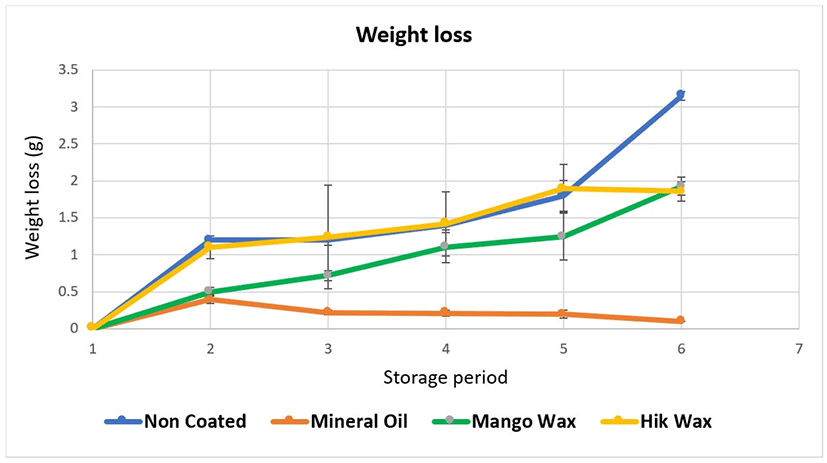
The HU is an expression relating to the egg weight and height of the thick albumen. The higher the HU value, the better the albumen quality of the egg, which is a generally accepted factor [5]. Changes in the HU of non-coated and coated eggs during five wks of storage at room temperature were observed (Fig. 2). Overall the HU decreased with the increasing storage periods may be due to the ovomucin proteolysis, breakage of disulfide bridges, or interaction between α and β ovomucins [34]. However, this decrement progressed at a much slower rate for PC and HW eggs than for NC and MW eggs (Fig. 2). Compared with NC eggs, PC and HW eggs had significantly higher (p < 0.05) HU throughout five weeks of storage. Also, there were no differences (p > 0.05) in MW eggs and NC eggs throughout five wks of storage. Based on the HU, eggs can be classified into four grades: AA (above 72), A (72–60), B (59–31), and C (below 30) [35]. The grade of NC eggs decreased rapidly from AA to C after four wks. PC eggs changed from AA to B after five wks of storage time. HW eggs changed from AA to B grade five wks of storage time. This study proved that MO and HW are good coating materials for preserving shell eggs. However, coating the eggs with MW was also observed to be more effective than non-coating (p < 0.05). A similar pattern of results was obtained by [11] that reported coating chicken eggs with plant waxes (Boomi and Dawul kurundu wax) enhanced the HU of egg albumen rather than non-coated eggs.
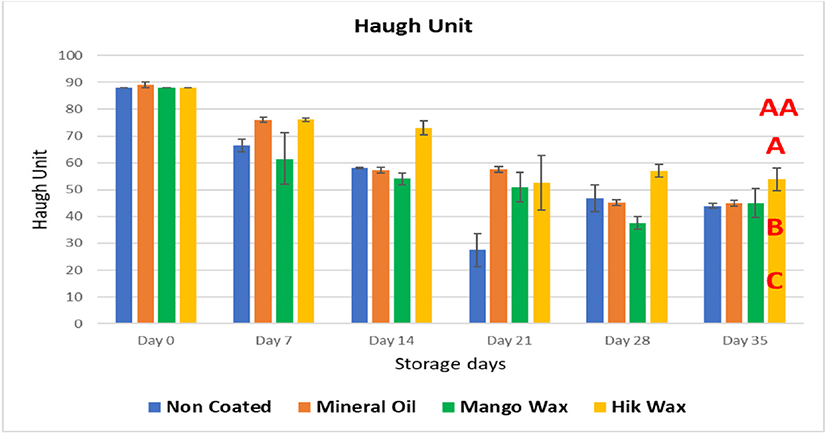
Same as the HU, albumen pH can also be used as an indicator of the albumen/egg quality. The albumen of a freshly laid egg contains 1.44–2.05 mg of dissolved CO2 (in the carbonate form), resulting in an albumen pH between 7.6–8.7 [13,36]. During storage, CO2 and water escape via eggshell pores, which increase the albumen pH up to 8.9–9.4 [11,37]. The albumen pH values of HW and MW eggs did not differ (p > 0.05) throughout the five wks of storage (Fig. 3). However, the pattern changes in albumen pH during the five wks storage period where higher albumen pH in HW eggs was reported over MW eggs (p < 0.05). However, both plant wax coatings effectively reduced (p < 0.05) the albumen pH when compared to non-coated eggs.
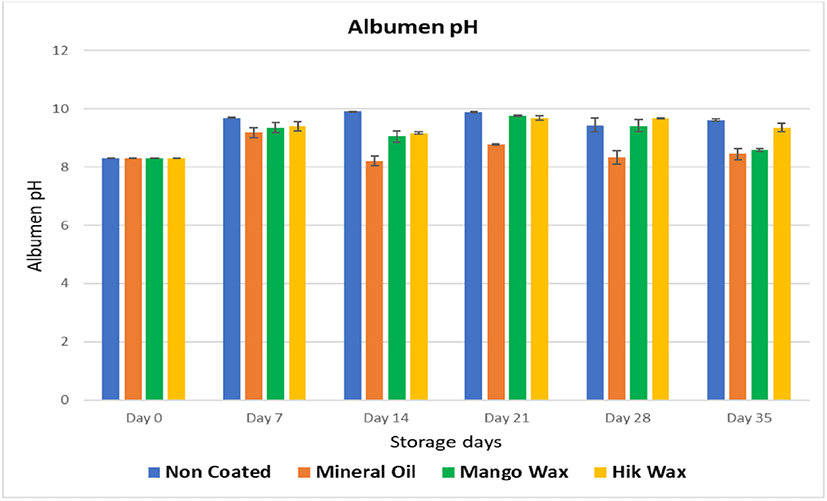
As similar as albumen pH, the yolk pH also increases from 6.0 to 6.4–6.9 with the storage due to the emission of water and CO2 via the shell [38]. In the present study, the yolk pH of NC, PC, HW, and MW eggs gradually increased from an initial value of 5.77 to 6.45, 5.77 to 6.2, 5.77 to 6.47, and 5.77 to 6.23 respectively (Fig. 4). MW eggs numerically reduced (p > 0.05) the yolk pH than HW eggs over the storage and were reported to be more effective as PC eggs to act as a barrier and help reduce the diffusions less rapidly through the shell when compared with non-coated eggs.
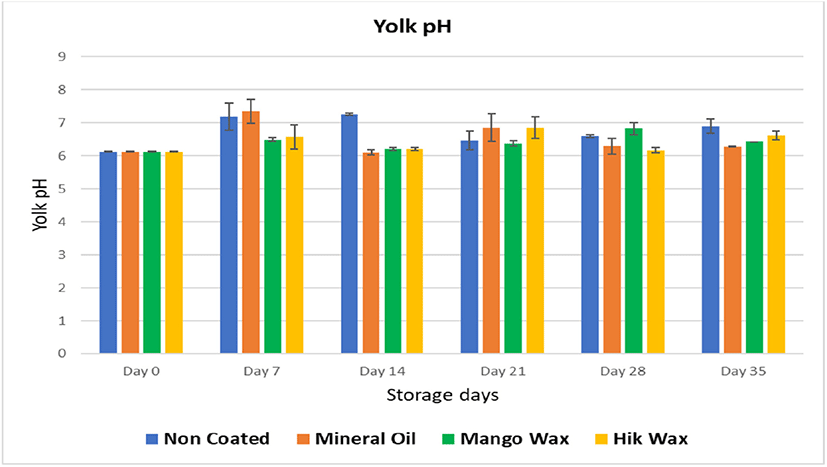
Nowadays, the color of egg yolk is a considerable factor in egg consumption. The latest surveys that were done in several different European countries (France, Germany, Italy, the UK, Spain, Poland, and Greece) have confirmed that the yolk color is one of the main parameters by which egg quality is judged [39]. According to the results, there was no coating effect (p > 0.05) on the yolk color observed during the storage periods (Table 1). Similarly, [21] reported that coating the eggs with Pterocarpus marsupium wax also did not affect the yolk color.
No suspected Salmonella colonies were detected in all non-coated and coated eggs throughout five wks of storage. Thus, our present results indicate that non-coated and coated eggs were microbiologically safe throughout five wks of storage at room temperature.
Albumen is known to have a secondary structure that includes alpha-helices, parallel beta-sheets, antiparallel beta-sheets, and random coils [40]. The application of IR spectroscopy to the analysis of protein secondary structure is based on the sensitivity of peptide group absorptions to the polypeptide chain conformation. In particular, the absorption of the amide 1 band (between 1,600 and 1,700 cm–1), mainly associated with the C = O stretching vibration and directly related to the protein backbone conformation, has been extensively used for the study of secondary structures [41]. Throughout five wks of storage, there were no differences (p > 0.05) in absorption units between 1,600 and 1,700 cm–1 wave numbers in all coated and non-coated eggs. In consequence, there were no differences (p > 0.05) in the secondary structure of egg albumen protein (Fig. 5).
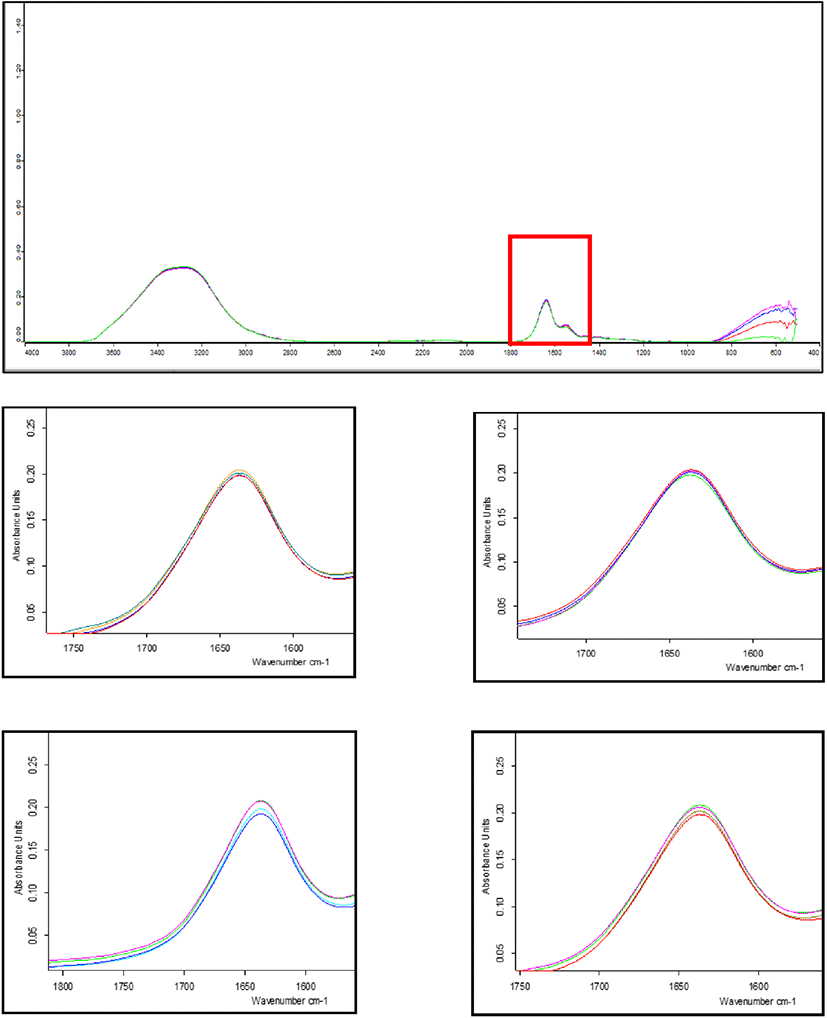
SEM images of the surface of eggshells perceive the idea of eggshell pores. Comparing the non-coated eggshell surface and coated eggs shell surface, the non-coated eggshell surface has more tiny pores (Fig. 6). It recommends either mineral oil or plant waxes capable of sealing eggshell pores.
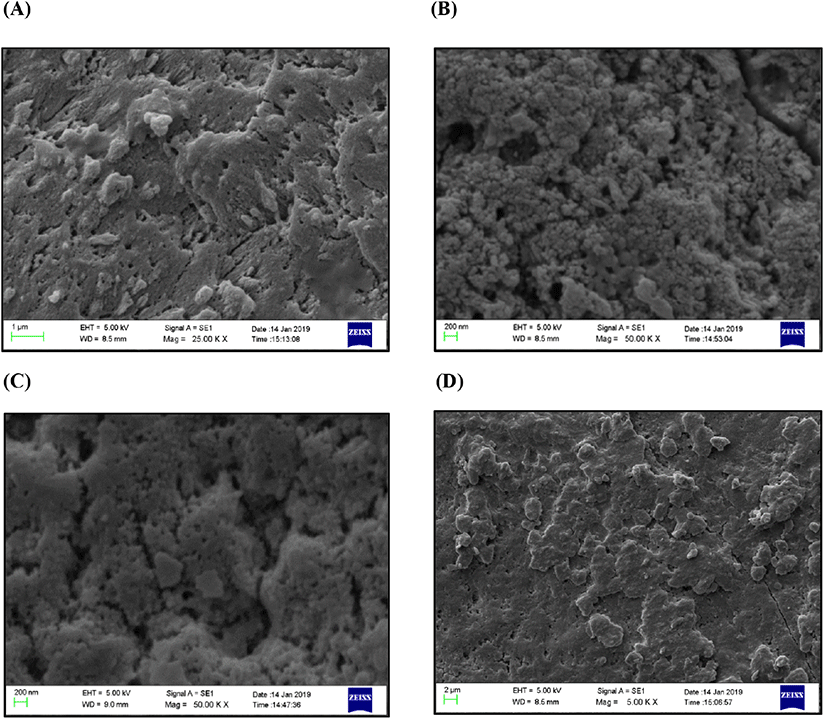
CONCLUSION
Coating table eggs with HW is not as effective as mineral oil, it was still effective in enhancing the shelf-life and improving the internal qualities of eggs rather than non-coating and coating with Mango wax during storage. However, both Hik and Mango wax could be used as potential shell-coating materials for eggs.
